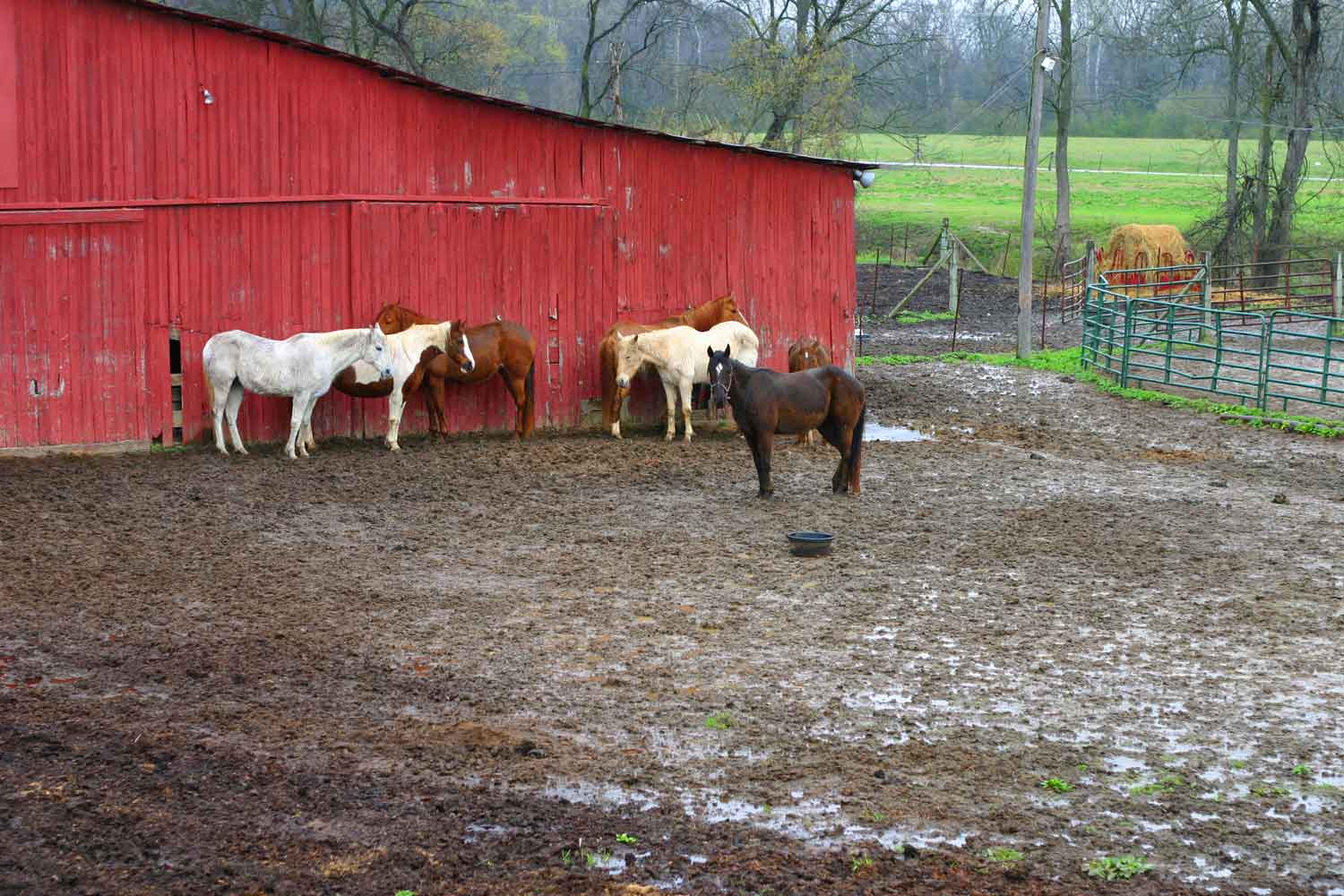
Throughout the year, horse owners work outside to care for their horses despite what challenges the forecast might offer. Precipitation, whether its rain, sleet or snow, eventually turns soil to mud and can create major hurdles for efficient horse management. In order to best manage muddy conditions, plans to manage precipitation should be made and permanent drainage solutions constructed.
Permanent Drainage Solutions
Facility layout is a key first step to permanent drainage solutions. Buildings, material storage, animal feeding areas, and shelters should be placed on higher ground as these areas tend to dry faster and precipitation tends to flow away. An ideal slope for this type of layout is between 4 and 6 degrees. In areas of heavy traffic where mud tends to accumulate (e.g., gates, laneways and dry lots), consider constructing a high traffic pad. High-traffic pads are specifically designed to improve drainage and provide stabilization through the use of multiple layers of permeable geotextile fabric and stones of various sizes.
How to Construct a High-Traffic Pad
To create better drainage, high-traffic pads should be constructed in areas that have reduced or no vegetation (e.g., dry lots) or are compacted from hoof traffic (e.g. laneways). Due to cost, it is rare that an entire dry lot will be constructed as a high traffic pad. Rather, select specific areas with a dry lot with a maximum slope of 6 degrees to help ensure that footing does not wash away.
Construction Steps
Remove 8 inches of the topsoil. Make sure that your base is level.
Install a drainpipe parallel to the high-traffic pad. Pipe should be permeable to allow for water to enter and be directed toward a drainage ditch. This step is optional and should only be included when an appropriate endpoint for water can be identified. For the drainpipe to work best, it should be encased in a permeable fabric and surrounded by gravel, similar to a French drain system. This will filter sediment and prevent blockage of the pipe.
Install the first layer of geotextile fabric across the base of the pad. A woven geotextile fabric should be used as it is durable and permeable. This allows water to drain while providing a stable base. It is best to construct your high traffic pad so it aligns with the width of the geotextile fabric (e.g., 10 to 12 feet).
Add 4 inches of crushed limestone. Stone should be between 1.5 to 1.75 inches in size.
Install a second layer of geotextile fabric. This encourages drainage by keeping the layers separated.
Top with a 4-inch layer of footing. Footing recommended is a fine gravel with fines (not washed). Different regions of the country call this type of gravel by different names, but dirty pea gravel is common. Crushed bluestone is also appropriate for a top layer of footing. When in doubt, consult an expert where you plan to purchase this material, they can direct you to a suitable product available in your region.
As a note, alternative grid systems are also available for high traffic pad construction. If these types of systems are used, consult the manufacturing company for installation guidelines.
Maintenance
Maintaining your high traffic pad is just as important as proper construction. Pick manure frequently to prevent nutrient runoff, the creation of more mud, and to reduce bacteria in the environment that might cause thrush, pastern dermatitis and cellulitis. Rake and refresh the high-traffic pad as needed to maintain a level surface.
Temporary Drainage Solutions
In the event that temporary, or emergency, mud management is required, dry spots can be constructed by adding gravel, dirt or sand to paddocks. These solutions should only be used when necessary as they lack the structure of high traffic pads and might result in erosion and nutrient runoff. Footing materials that readily decompose such as straw, hay and wood chips should be avoided.
Other Precipitation Management Recommendations
Install gutters on all buildings and utilize drainage ditches and swales to direct precipitation towards these areas.
In regions where snowfall is expected, create a plan for piling snow to ensure that you can accommodate snow melt in the spring. As a reminder, make sure that precipitation and melting snow are not draining into manure piles as this can create nutrient runoff.
Manure should always be stored on a non-porous pad (e.g. concrete) and removed regularly, following state and local codes.
Horse Health Concerns in Muddy Environments
Horses exposed to muddy environments should be checked daily for signs of thrush, pastern dermatitis and cellulitis. These conditions are perpetuated by wet environments and can be worsened by the presence of bacteria. Daily removal of manure can aid in reducing bacteria in the environment.
The author of his article is Aubrey Jaqueth, PhD, University of Minnesota. For more information visit the University of Minnesota’s horse page.


